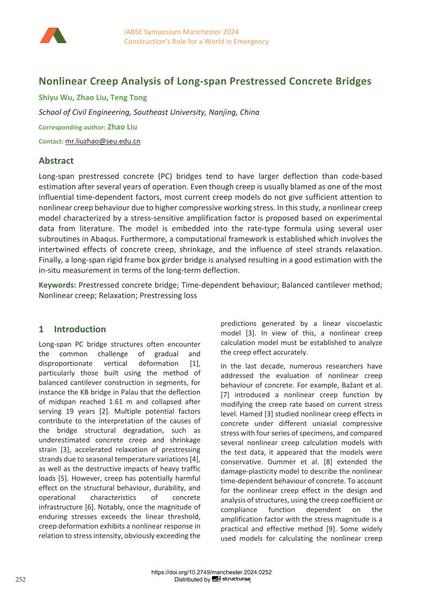Nonlinear Creep Analysis of Long-span Prestressed Concrete Bridges

|
|
|||||||||||
Bibliographic Details
| Author(s): |
Shiyu Wu
(School of Civil Engineering, Southeast University, Nanjing, China)
Zhao Liu (School of Civil Engineering, Southeast University, Nanjing, China) Teng Tong (School of Civil Engineering, Southeast University, Nanjing, China) |
||||
|---|---|---|---|---|---|
| Medium: | conference paper | ||||
| Language(s): | English | ||||
| Conference: | IABSE Symposium: Construction’s Role for a World in Emergency, Manchester, United Kingdom, 10-14 April 2024 | ||||
| Published in: | IABSE Symposium Manchester 2024 | ||||
|
|||||
| Page(s): | 252-259 | ||||
| Total no. of pages: | 8 | ||||
| DOI: | 10.2749/manchester.2024.0252 | ||||
| Abstract: |
Long-span prestressed concrete (PC) bridges tend to have larger deflection than code-based estimation after several years of operation. Even though creep is usually blamed as one of the most influential time-dependent factors, most current creep models do not give sufficient attention to nonlinear creep behaviour due to higher compressive working stress. In this study, a nonlinear creep model characterized by a stress-sensitive amplification factor is proposed based on experimental data from literature. The model is embedded into the rate-type formula using several user subroutines in Abaqus. Furthermore, a computational framework is established which involves the intertwined effects of concrete creep, shrinkage, and the influence of steel strands relaxation. Finally, a long-span rigid frame box girder bridge is analysed resulting in a good estimation with the in-situ measurement in terms of the long-term deflection. |
||||
| Keywords: |
balanced cantilever method prestressed concrete bridge time-dependent behavior relaxation Nonlinear creep Prestressing loss
|
||||
